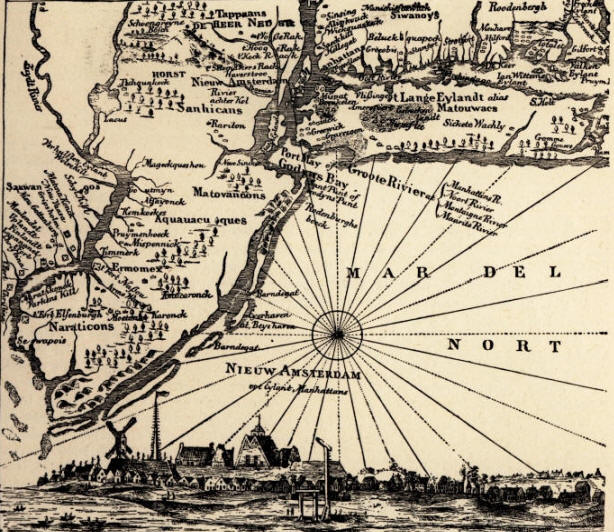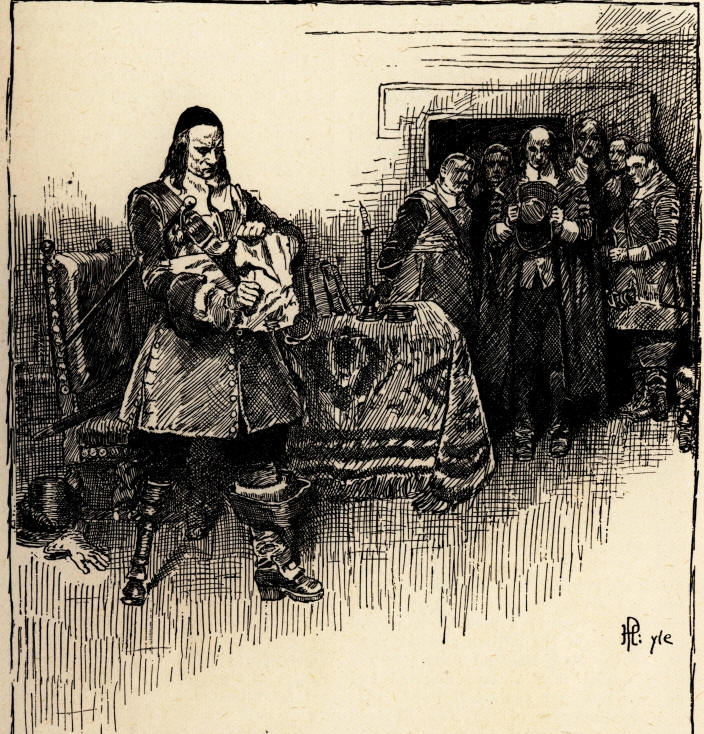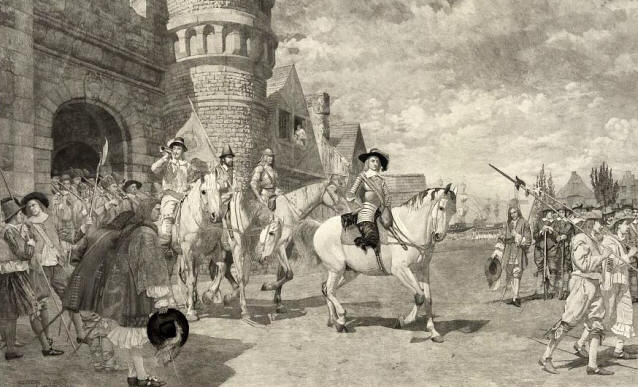New Netherland
|
|
This Site:
|
Peter Stuyvesant, in 1664, standing among residents of New Amsterdam who are pleading with him to surrender to the British who have arrived in warships to claim the territory for England
Map of New NetherlandWhile Wouter Van Twiller was governor of New Netherland, Jacob Eelkins, the Dutch West India Company's former commandant at Fort Orange, entered the mouth of the Hudson in an English vessel (April 18, 1633) , and avowed his determination to ascend the river and trade with the Indians. He was in the English service, and claimed that the country belonged to the English, because it had been discovered by a subject of England, Hudson. Van Twiller ordered the Orange flag to be raised over Fort Amsterdam as the best defiance of the intruder. Eelkins as promptly ran up the English flag above his vessel (the William), weighed anchor, and sailed up the river. This audacity enraged Van Twiller. He gathered the people, opened a barrel of wine, drank glassful after glassful, and cried, " You who love the Prince of Orange and me do this, and assist me in repelling the insult committed by that Englishman." Having thus unburdened his soul, the governor retired within the fort. Later in the day the energetic De Vries dined with the governor, and reproved him for his show of impotence. After a few days of hesitation, some small craft with some soldiers were sent after Eelkins, and after the lapse of about a month the William was expelled from the harbor. The Dutch Encourage Emigration to the New WorldThe Dutch early took measures to encourage emigration to New Netherland. By a new " Charter of Privileges and Exemptions," adopted July 17, 1640, patroonships were limited, for the future, to 4 miles of frontage on navigable waters, with a depth of 8 miles; and every person transporting himself and five others to the colony was allowed 200 acres of land; and such villages and towns as might be formed were to have magistrates of their own choosing. A proclamation was issued offering free-trade to New Netherland (in the ships of the West India Company) and transportation thither to all who wished to go ; and emigrants were offered lands, houses, cattle, and farming tools at a very moderate annual rent, and a supply of clothes and provisions on credit. At that time, of the ten large patroonships originally established, only Rensselaerswick remained. Immigrants, composed chiefly of persecuted persons or indentured servants who had served out their time, flocked into New Netherland, where they might enjoy freedom such as existed in Holland. They came from New England and Virginia, and very soon there was a considerable English element in society in New Netherland. Colonists Suffer in New NetherlandsThe first address of the people of New Netherland to the authorities in Holland was in October and November, 1643. The savage conduct of Governor WILLIAM KIEFT towards the surrounding Indians had brought the Dutch colony into great distress because of the hostilities of the natives. Kieft, in the extremity of perplexity, had called the people together to consult upon the crisis, and begged them to choose a new popular council. They chose eight energetic citizens, who seized the reins of government and prepared for defense. On October 24 they addressed to the College of XIX. at Amsterdam, and on Nov. 3, to the States-General, statements of the sad condition of the colony caused by Kieft's bad conduct. Two letters were also sent directly by citizens of New Amsterdam, written in simple but eloquent language. In these letters the Eight Men drew a pitiable picture of their sufferings-women and children starving ; their homes destroyed ; the people skulking around the fort at Manhattan, where they were " not one hour safe." They prayed for assistance to save them from " the cruel heathens." The winter that followed was a terrible one in New Netherland. A second appeal from the Council of Eight Men at Manhattan to the College of XIX., in October, 1644, reached that body while it was considering the first address. The second gave a bolder and more definite statement of the grievances of the colonists, and more specific charges against the governor, to whose acts all their troubles were attributed. They asked for his recall. The States-General had already peremptorily ordered the West Indian Company to take measures to relieve the people, but the corporation was bankrupt and powerless. The immediate purpose of the Eight Men was gained, for Kieft was ordered to Holland, and Lubbertus Van Dincklagen, the former sheriff, was appointed provisional governor, until the commission of Peter Stuyvesant was issued in May, 1645. Preparations for WarUncas, the Mohegan sachem, always bent on mischief, spread a report, in the spring of 1653, that Ninegret, a Niantic sachem, uncle of Miantonomoh, had visited New Amsterdam during the preceding winter, and had arranged with the Dutch governor (Stuyvesant) a plot for a general insurrection of the natives and the murder of the New England settlers. The story caused such alarm (England had just declared war against Holland) that the commissioners of the New England confederacy assembled in special session at Boston in May. They sent messengers to Ninegret and Pessacus to inquire into the matter, and envoys and a letter to Governor Stuyvesant. They also ordered 500 men to be raised, to be ready in case " God called the colonists to war." The sachems totally denied any knowledge of such a plot, and Stuyvesant indignantly repelled even a suspicion, and sent back a declaration of the grievances of the Dutch. These denials were rebutted by the testimony of English and Indian malcontents in New Amsterdam. On the report of the envoys, the commissioners at Boston determined on war ; but the General Court of Massachusetts desired the opinions of the clergy. The latter thought they saw plain evidence of " an execrable plot tending to the destruction of many dear saints of God," but were opposed to going to war. Other ministers urged war, and so did a majority of the commissioners, but the General Court denied the power to make " offensive war " without unanimous consent. Meanwhile Connecticut and New Haven, bent on war, united in a solicitation to Cromwell to fit out an expedition to conquer New Netherland, and the towns of Stamford and Fairfield, on the Dutch frontier, attempted to raise volunteers to make war against the Dutch on their own account. At another meeting (September, 1653) the commissioners, believing they were " called by God to make present war on Ninegret," ordered 250 men to be raised for that purpose. The Massachusetts court again interfered, and prevented war. Cromwell, however, sent three ships and a few troops to attack New Netherland, but before they reached America the war with Holland was over, and the expedition, under John Leverett and Robert Sedgwick, proceeded to capture ACADIA from La Tour, who laid claim to it because of a grant made to his father by Sir William Alexander.
STUYVESANT TEARING UP THE LETTER DEMANDING SURRENDERLate in August, 1664, a land and naval armament, commanded by Col. Richard Nicolls, anchored in New Utrecht Bay, just inside of the present Coney Island. There Nicolls was joined by Governor Winthrop, of Connecticut, several magistrates of that colony, and two leading men from Boston. Governor Stuyvesant was at Fort Orange (Albany) when news of this armament reached him. He hastened back to New Amsterdam, and on August 30, Nicolls sent to the governor a summons to surrender the fort and city. He also sent a proclamation to the citizens, promising perfect security of person and property to all who should quietly submit to English rule. Stuyvesant assembled his council and the magistrates at the fort for consultation. The people, smarting under Stuyvesant's iron rule, panted for English liberty, and were lukewarm, to say the least. The council and magistrates favored submission without resistance. The governor, true to his superiors and his convictions of duty, would not listen to such a proposition, nor allow the people to see Nicoll's proclamation. Two days afterwards the magistrates explained to the people the situation of affairs. They demanded a sight of the proclamation; it was refused. They were on the verge of open insurrection, when Governor Winthrop, with whom Stuyvesant was on friendly terms, came from Nicolls with a letter demanding a surrender. The two governors met at the gate of the fort. On reading the letter, Stuyvesant promptly refused. He read the letter to his council and the assembled magistrates. " Read it to the people and get their mind," they said. The governor stoutly refused; his council and the magistrates as stoutly insisted that he should do so, when the enraged governor, who had fairly earned the title of "Peter the Headstrong," in a towering passion, tore the letter in pieces. Hearing of this, a large number of the people hastened to the state-house, and sent in a deputation to demand the letter. Stuyvesant stormed. The deputies were inflexible, and a fair copy was made from the pieces and read to the inhabitants. The population of New Amsterdam did not exceed 1,500 souls, and not more than 200 were capable of bearing arms. Nicolls sent another message to the governor, saying, "I shall come for your answer tomorrow with ships and soldiers." Stuyvesant was unmoved. And when men, women, and children, and even his beloved son, Balthazar, entreated him to surrender, that the lives and property of the citizens might be spared, he said, "I had much rather be carried out dead." At length, when magistrates, clergy, and the principal citizens entreated him, the proud soldier consented to capitulate. On Monday morning, September 8, he led his troops from the fort to a ship on which they were embarked for Holland; and an hour afterwards the royal flag of England was floating over Fort Amsterdam, the name of which was changed to Fort James, in honor of the Duke of York. The remainder of New Netherland soon passed into the possession of the English.
Dutch soldiers, lead by Director General Peter Stuyvesant, leaving New Amsterdam after ceding it to the EnglishTerritory Retaken by the DutchCharles II. granted the province of New Netherland to his brother James, Duke of York, without competent authority, and, having the power, the duke took possession by an armed force in 1664, and ruled it by governors appointed by himself. The name of the province was changed to New York. In 1673, the English and Dutch were again at war. A Dutch squadron, after capturing many English trading vessels returning from Virginia, appeared before New York. The governor, Francis Lovelace, was absent in Connecticut, and Colonel John Manning was in command of the renamed Fort James. English despotism had weakened the allegiance of the inhabitants of the city, who were mostly Dutch, and who found that their expectations of enjoying "English liberty" were not gratified. When they demanded of the governor more liberty and less taxation, he had unwisely declared, in a passion, that they should have "liberty for no thought but how to pay their taxes." This was resented; and when the Dutch squadron came (July 30, 1673), nearly all the Hollanders in the city regarded their countrymen as liberators. The city was virtually reconquered when the summons to surrender was made. When Manning beat the drums for volunteers to defend the town, few came, and those not as friends, for they spiked the cannon in front of the state-house. Manning sent a messenger for Lovelace; and when the Dutch ships came up and fired broadsides upon the fort, he returned the fire, and shot the enemy's flagship "through and through." Then 600 soldiers landed on the shores of the Hudson above the town, where they were joined by 400 Dutch citizens in arms, who encouraged them to storm the fort. They were marching down Broadway for that purpose, when they were met by a messenger from Manning with a proposition to surrender it if his troops might be allowed to march out with the honors of war. The proposition was accepted. The English garrison marched out and the Dutch troops marched in. The flag of the Dutch republic waved over Fort James, which was now renamed Fort William Hendrick, and the city was called New Orange, both in honor of William, Prince of Orange. The province was again called New Netherland. Tensions Between British and Dutch in the New WorldFor many years there were sharp disputes between New Netherland and its colonial neighbors concerning boundary lines. On Sept. 19, 1650, Governor Stuyvesant arrived at Hartford, and demanded of the commissioner of the Connecticut colony a full surrender of the lands on the Connecticut River. After a consultation for several days, it was agreed to leave the matter to arbitrators. The commissioner chose Simon Bradstreet, of Massachusetts, and Thomas Prince, of Plymouth ; Stuyvesant chose Thomas Willett and George Baxter, both Englishmen. It was agreed that on Long Island a line should be drawn from the westernmost part of Oyster Bay straight to the sea; the easterly part to belong to the English, the remainder to the Dutch. On the mainland a line should begin at the west side of Greenwich Bay, about 4 miles from Stamford, and run northerly 20 miles; and beyond that distance, as it should be agreed by the two governments of the Dutch and New Haven, provided that line should not come within 10 miles of the Hudson River. It was also agreed that the Dutch should not build a house within 6 miles of the dividing line. In 1659 a deputation arrived at New Amsterdam from Maryland to present the claim of Lord Baltimore to the whole territory of the South River, or Delaware, to lat. 40° N. The Dutch resorted to negotiation instead of a hopeless open resistance by arms, though the courageous Stuyvesant was disposed to do so. After much discussion the Baltimore patent was shown to the commissioners, in which was a clause limiting the proprietor's grant to lands hitherto uncultivated and inhabited only by Indians. The Dutch commissioners rested their case on this clause. They argued that the South River region was distinctly excluded from Lord Baltimore's patent by its own terms, inasmuch as when the grant was made that country had been purchased of the Indians by the Dutch some time before. The argument was unanswerable. Here the controversy about jurisdiction ceased, but the matter was never adjusted between the Dutch and English. On the surrender of New Netherland to the English (1664) and the change of its name to New York, the commissioners to whom the conquest of the Dutch province and the settlement of troubles in New England had been entrusted, proceeded to define the boundary between the colonies of New York and Connecticut. It was decided that the boundary should be 20 miles east of the Hudson River and run parallel to it. It was determined that the line should run N.N.W. from tide-water on the Mamaroneck to the southern limits of Massachusetts; but it was found that this line would cross the Hudson in the Highlands and not run parallel with it- certainly not 20 miles east of it. The commissioners reversed their decision, and the controversy was renewed. In 1683 another boundary commission was appointed. It was finally agreed to allow New York the whole of Long island and all the islands in the Sound to within a few rods of the Connecticut shore, and Connecticut to extend her boundaries west along the Sound to a point within about 15 miles of the Hudson, the strip extending an average of about 8 miles north of the Sound; New York to receive a compensation in the north by the surrender of a narrow tract of 61,-440 acres, called " The Oblong," by Connecticut. The lines were established in 1731; but the exact line remaining a subject of dispute, commissioners were appointed in 1856 to fix it, but they failed to agree. Canonists Extended Important RightsIn 1683, when Thomas Dongan was made governor, the people asked for more political privileges, and the duke instructed him to call a representative assembly. It met in the fort at New York on Oct. 17, 1683, and sat three weeks, passing fourteen acts, all of which were approved by the governor. The first act was entitled " The Charter of Liberties and Franchises granted by his Royal Highness to the Inhabitants of New York and its Dependencies." The duke approved the act. It declared that supreme legislative power should forever be and reside in the governor, council, and people, met in General Assembly; that every freeholder and freeman should be allowed to vote for representatives without restraint; that no freeman should suffer but by judgment of his peers; that all trials should be by a jury of twelve men; that no tax should be assessed, on any pretence whatever, but by the consent of the Assembly; that no seaman or soldier should be quartered on the inhabitants against their will ; that no martial law should exist; and that no person possessing faith in God by Jesus Christ should at any time be anywise disquieted or questioned for any difference of opinion. Two years afterwards the duke succeeded to the throne as James II., when he at once struck a severe blow at this fabric of liberty. James as king broke the promises of James as duke. He had become an avowed Roman Catholic, and determined to fill all offices in his realm with men of that creed. He levied direct taxes on New York without the consent of the people, forbade the introduction of printing, and otherwise established tyranny (see DONGAN, THOMAS). He refused to confirm the charter of 1683, but he dared not attempt to suppress the General Assembly, the first truly representative government established in New York. See NEW YORK) |
|
|
||
|
|
Site Copyright 2003-2018 Son of the South. For Questions or comments about this collection, contact: paul@sonofthesouth.net |
|
|
Are you Scared and Confused? Read My Snake Story, a story of hope and encouragement, to help you face your fears. |
||
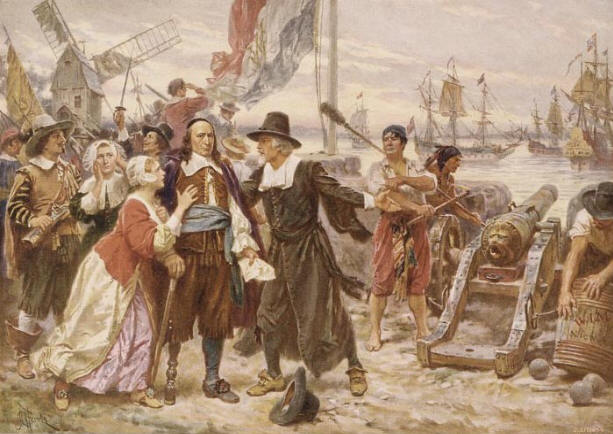
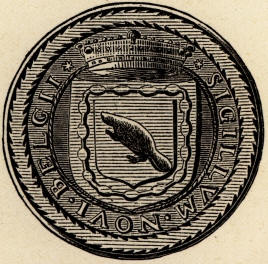 New
Netherland. To the Binnenhof, at The Hague, repaired
deputies from the Amsterdam company of merchants and traders to have
an audience with the States-General of Holland, to solicit a charter
for the region in America which the discoveries of
New
Netherland. To the Binnenhof, at The Hague, repaired
deputies from the Amsterdam company of merchants and traders to have
an audience with the States-General of Holland, to solicit a charter
for the region in America which the discoveries of
